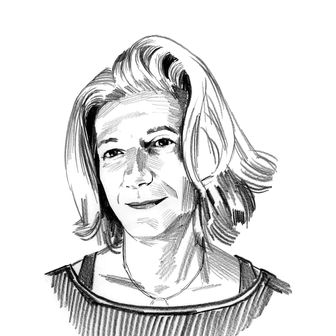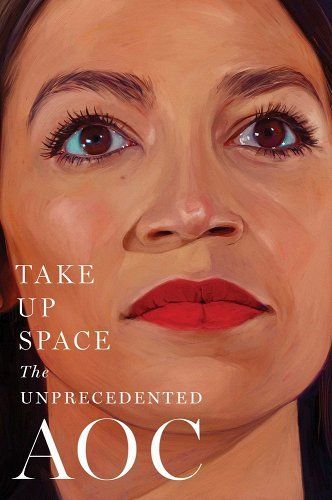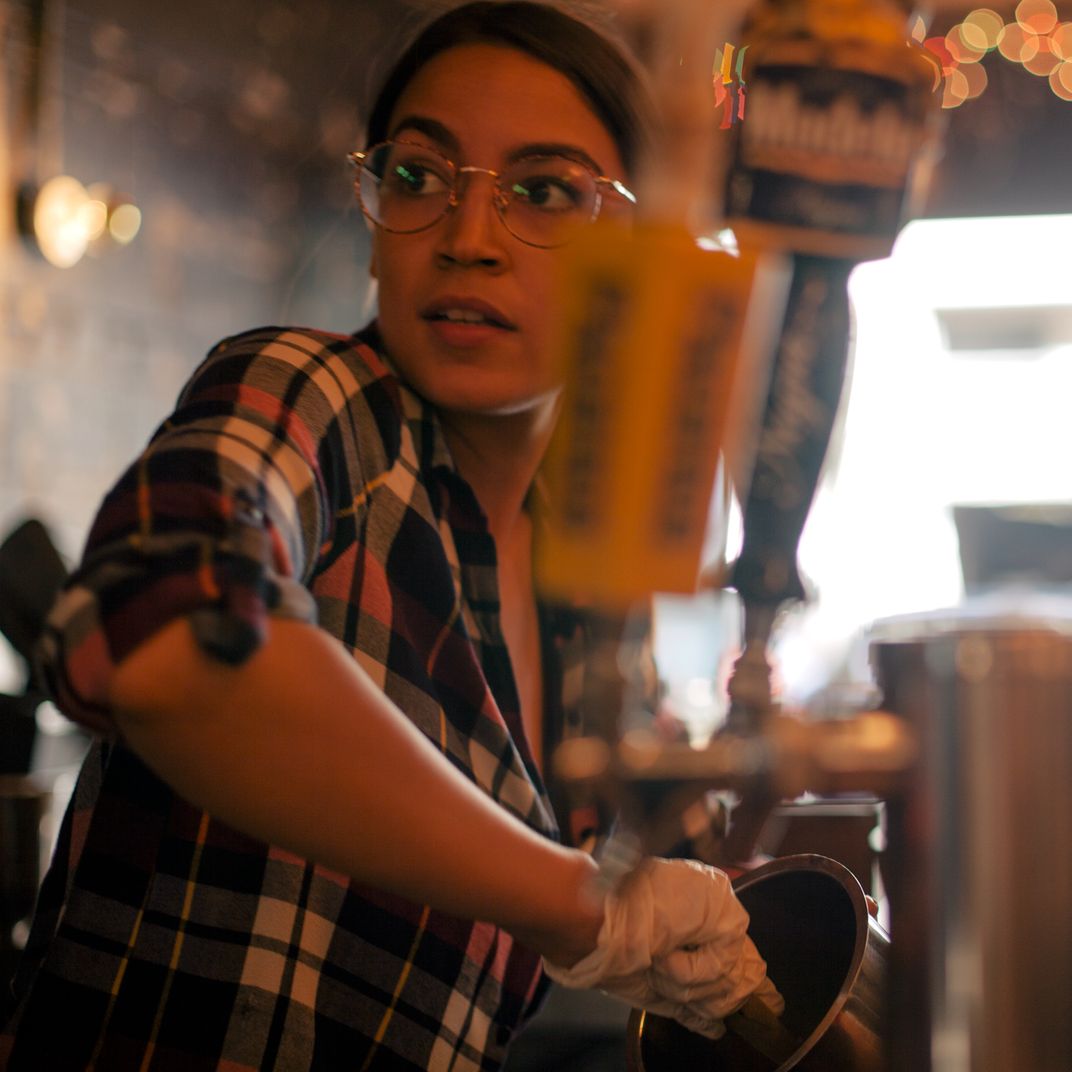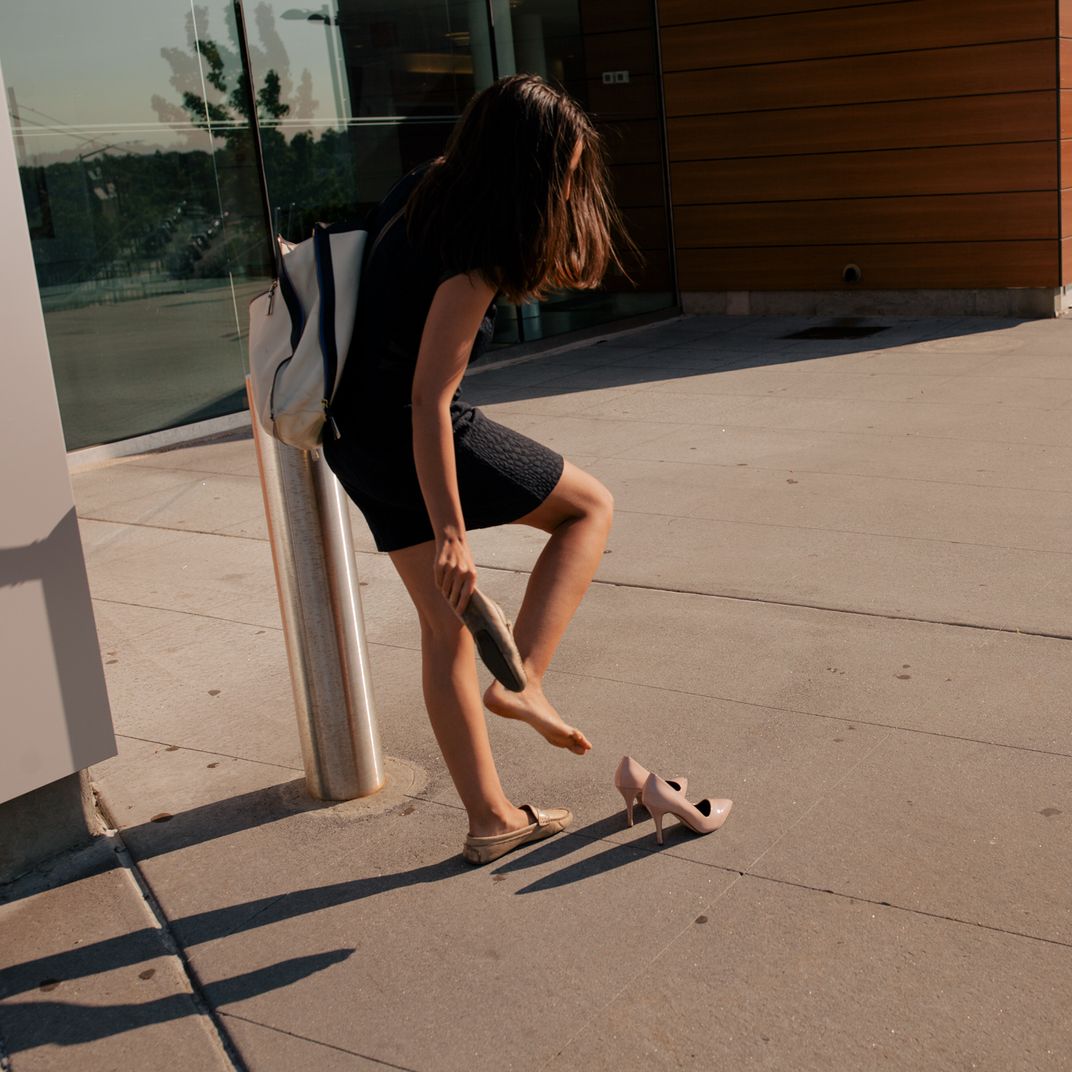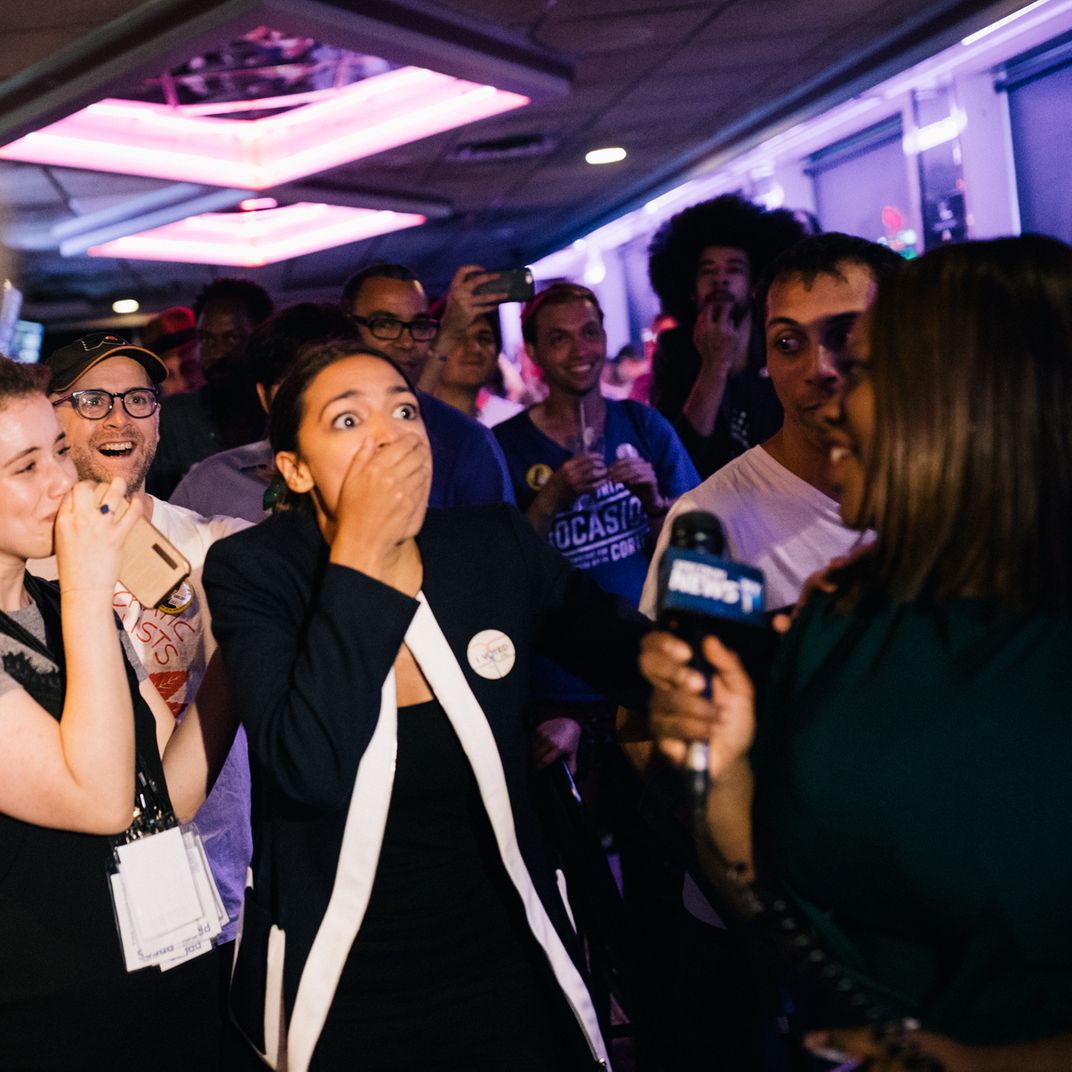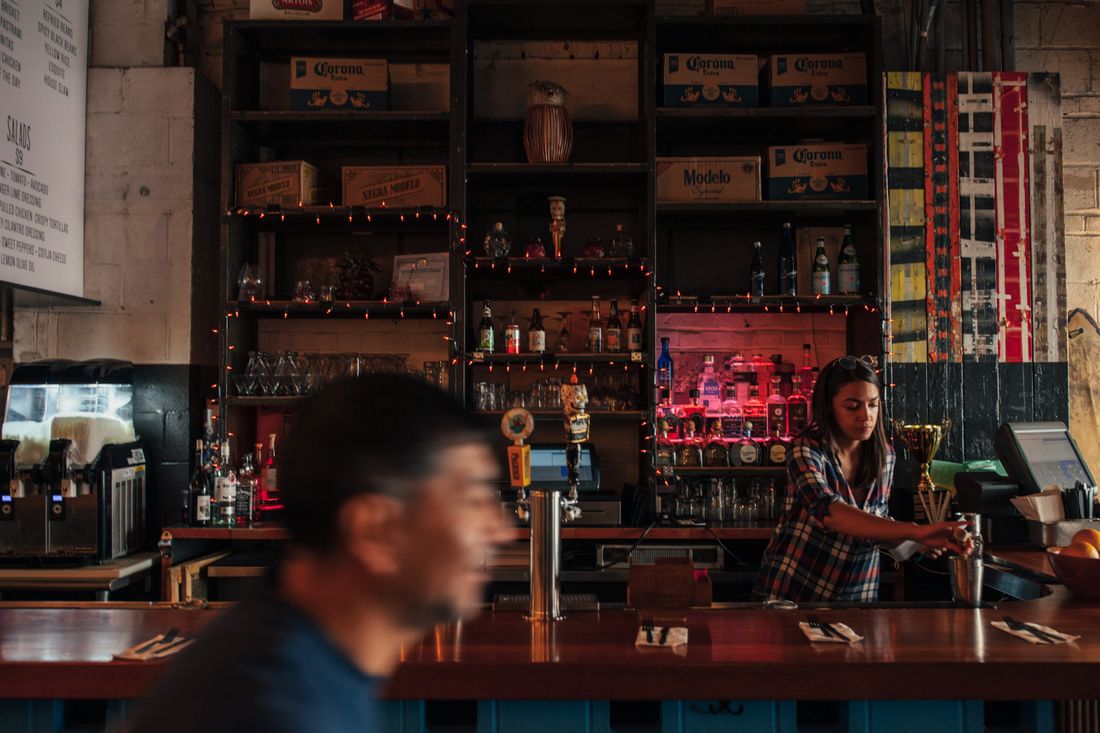
This article was featured in One Great Story, New York’s reading recommendation newsletter. Sign up here to get it nightly.
Even her haters call her a “generational talent,” a disparagement candy-wrapped as a compliment, the implication being that the astonishing rise of Alexandria Ocasio-Cortez was somehow encoded in her DNA. Frame a thing as expected and it can be discounted. But rewind five years and it becomes clear just how unprecedented her rise has been. “Women like me aren’t supposed to run for office,” she said at the start of her journey to Washington. She was only stating facts. Months before AOC became the new face of the Democratic Party, she was working in a bar where she was expected to look “hot,” riding the 6 train, fretting about health insurance, and not really sure what she wanted to do with her life.
Her victory on June 26, 2018, over her mainstream Democratic opponent, Joe Crowley, was a marker delineating the moment after which American politics would never be the same. It established AOC’s prodigious political gifts while showcasing a new sort of Democratic candidate and a new way of recruiting them. Barack Obama, previous holder of the “generational talent” title, may have resembled Ocasio-Cortez in some ways. Brown-skinned, good looking, with his own misadventures in the postcollegiate wilderness, he challenged political convention even as he titillated its guardians. But he had a résumé — the first Black president of the Harvard Law Review, constitutional-law professor at the University of Chicago — that the Democratic-consultant class could easily recognize and safely admire. The Establishment didn’t know what to make of AOC. As she put it in an interview then, “If a spaceship landed in your backyard, it’s like, ‘What the fuck is that? Is it going to hurt me?’ ”
Latina and working class, Ocasio-Cortez was demographically distinct from her new colleagues in Congress. She also represented a new generation. With the skills of a social-media influencer, Ocasio-Cortez helped bring the millennials and their younger siblings into battle. She was cool, gorgeous, a digital polyglot — she streamed, she posted, she tweeted — but she also loved literature, photography, and fashion. Her leftist mission, her savantlike communication skills, and her moral ferocity propelled her rise, but what people loved about her, at the beginning, was that she was regular. Not, like Crowley and other career pols, ostentatiously folksy. Ocasio-Cortez was really regular: vulnerable, fun, someone you might actually know, like your friend’s roommate.
As Americans turn their attention to this midterm year, Ocasio-Cortez has shown that her brand of politics can be formidable. With more than 20 million followers on Twitter and Instagram combined, and the ability to raise $20 million mostly in small-dollar donations in a single campaign cycle, she has amassed so much power that she is a human incendiary device. But as her public persona eclipses the waitress who launched that out-of-nowhere run against Crowley four years ago, she is in danger of becoming more prop than person. Whether the Democrats keep Congress or lose it in 2022, the result will be cast by the natterers as her influence or her fault. The transformation of Ocasio-Cortez from lost millennial into the incarnation of every American hope and fear has been dizzying.
It might serve at this moment to look away from the blinding star she has become and to the mechanics of her rise, for it’s there that the arguments for optimism lie. Since she was elected with the help of former operatives in the Bernie Sanders presidential campaign, her greatest achievements have been a new generation’s continued interest in politics and the door she has left wide open behind her. Blacks, Hispanics, Asians, Native Americans, and women are entering Congress in historic numbers, though there are still surely not enough to be truly representative. If not for Ocasio-Cortez, there would have been no Squad, and the Congressional Progressive Caucus would not have evolved into a powerhouse. At the very beginning, before she had been elected to anything, Ocasio-Cortez revealed her mission in what would become her mantra. “We can only accomplish great things together,” she said.
Ocasio-Cortez, like so many other people of color in her generation, had been seduced by the promise that higher education would open up opportunities.
But life out of college was a shock, as it was for millions of other millennials entering the postrecession job market. Her father, Sergio, who had died when she was a sophomore at Boston University, had told her she was special, destined for greatness, capable through intelligence and grit of attaining her dreams, and her education had reinforced that notion. But upon graduating in 2011, she saw that it didn’t matter how smart she was, what she knew, how ambitious or imaginative her ideas were. It didn’t matter that she’d won science prizes; been chosen to give speeches; immersed herself in economics, music, and literature; and graduated cum laude. Sandy, as she was sometimes known back then, was a petite young Puerto Rican woman with bills to pay. She moved into an apartment in the Parkchester development in the Bronx that had belonged to her father, with $25,000 in student loans and no health insurance. Up in Yorktown Heights in Westchester, her family relied on food stamps.
Throughout high school and college, she had attended the National Hispanic Institute, a youth leadership organization, and now she was given a paid fellowship there, helping the administrators develop high-school curricula, traveling the country to set up and lead summer programs, and receiving a grant to try to launch a series of children’s books with Latino characters. She wanted to share the pleasure of reading with young kids in the barrio, who, she thought, might more easily take to it if they saw themselves reflected in the books. But she wasn’t able to get the series off the ground. At around the same time, she rented space at a small-business incubator in the Bronx. People who knew her then remember her working on a tool to help educators track kids’ emotional and mental health. She took meetings and reached out through her networks, but that project was going nowhere as well, and she became extremely discouraged.
“Alex, I think, had a Mary Poppins understanding that you follow a particular pathway, and bingo! You’re successful,” says Ernesto Nieto, a co-founder of the NHI. When she foundered, she felt she was to blame. Facing the disparity between how she saw herself and how the world saw her “was not very pleasant,” Nieto adds. “That’s the journey for a lot of Latinos. The same doors are not there for us as for somebody else.”
On long car rides to NHI events, Ocasio-Cortez and Nieto swapped stories of losing loved ones at a young age, of living between the city and the suburbs, of shouldering the responsibility of caring for family. Nieto tried to frame Ocasio-Cortez’s struggles as systemic, not owing to any shortcoming on her part. Only recent college graduates with family support could afford to gild their résumés with high-prestige, low-paying internships or to take the financial risk of starting a business. In the car, unburdening themselves to each other, Ocasio-Cortez and her mentor would cry.
Exhausted, Ocasio-Cortez turned to waitressing, which was at least reliable. “Working with young people, as immensely fulfilling as it is, did not pay the bills,” she told Cornel West and Tricia Rose in 2020. There was something liberating, finally, about abandoning the imagined, idealized path to a fantasy career in favor of meeting the pressing need. On a good night, she could earn hundreds of dollars — cash — which she would stash in a purse against future expenses. She worried about what her father would think of her life, whether he would be disappointed in her, but she also felt unshackled by admitting that this was what she needed to do for now. Whenever she tried to map her life in terms of achievements or goals, “I was deeply unhappy,” she has said. “And when I started focusing more on how I want to be, I was much happier, even when I was a waitress.”
At Coffee Shop — as well as its sister location next door, the taqueria Flats Fix — Ocasio-Cortez found herself, once again, at the center of a scrappy group of millennial outsiders. Founded in 1990, Coffee Shop was a model joint in its heyday. Owned by models, staffed by models, patronized by models, it had the after-hours feel of a high-tone speakeasy. “The revolving door of people that came through there was insane,” remembers Jesse Korman, a photographer who often took work meetings at the restaurant and was dating one of the bartenders. “Artists and high-end celebrities and crazy tech entrepreneurs and music-industry people and normal people.” Speakers mounted behind the bar played Brazilian music and indie rock. By the time Ocasio-Cortez worked there, its flash had faded, but it retained the flavor of a hot spot.
The staff understood that beauty was a prerequisite for employment. Waiters and bartenders were often hired by the owner, former model Carolyn Benitez, who appeared to conduct job interviews like casting calls. “She’d say, ‘Come on and sit in the booth,’ and she looks you up and down,” remembers Maria Swisher, who worked with Ocasio-Cortez behind the bar. “She asked me how to make these two trashy cocktails that you really don’t need to know how to make in order to be a bartender. A Slippery Nipple, or something. And I was like, ‘I don’t know, I can make you an old-fashioned.’ ” Bartenders were expected to look hot at work. “I think it even said in our manual we were supposed to look fashionable,” Swisher says, “and it was always very unclear what that was supposed to mean.” Ocasio-Cortez, sometimes wearing red lipstick, her hair up in a messy bun, “probably dressed the most conservatively.”
The front-of-house crew at the restaurant was an assortment of creative, idiosyncratic anti-authority types familiar to anyone who has ever been young in New York. Swisher was doing political theater; another bartender was a performance artist launching a fashion line; a third was a sailing instructor and tarot-card reader. “It was this free-spirited thing — Hey, we’re in New York City figuring things out,” Korman, the photographer and patron, recalls. The Coffee Shop girls, as he called them, were always high-energy, operating at a ten and yelling at one another across the room.
Restaurant work has always been a temporary solution for people who are between things or hard up. Ocasio-Cortez has since spoken of the very exploitative nature of this work, the undocumented old men washing dishes in the kitchen, the front-of-house staff working mainly for tips, without protections or benefits or scheduled breaks. She translates this experience into an equity fable of how, for some, bad luck can lead straight to financial calamity, forcing a person to hold down a demanding, demeaning job to keep from drowning, while business and government perpetuate the notion that misfortune is somehow the sufferer’s fault. But this was personal for her. At the restaurant, “so many of the people that I worked with had parents that passed away, or they were born in circumstances that led to these outcomes,” she said. “Whereas in society we’re taught you’re there because that is what you deserve. You didn’t work hard enough. You didn’t educate yourself enough. You had messed up in some way.”
But while she was stalled professionally, Ocasio-Cortez was also just living her life, working constantly, hanging out with the restaurant people and friends from Boston University. After work, the Coffee Shop crew often went to a bar nearby, a small, dark place where everyone knew the bartender. Ocasio-Cortez was never a partyer, but like so many New Yorkers, she loved the adrenalized adventure of exploring undiscovered corners of the city. There was a kava bar on 10th Street that she and Swisher would visit; her friend Eric Baker remembers once meeting her at a hookah lounge after work. “I don’t know if she had any fun, but I had a lot of fun watching her try hookah,” he recalled. Ocasio-Cortez was clearly at a crossroads in life, “just turning over how she was going to move forward,” Baker said. Though Ocasio-Cortez and her boyfriend Riley Roberts had split up near the end of college after dating for much of their senior year, they were back together, working it out and doing a long-distance thing — he was in Arizona helping start-ups with digital marketing and planning to move to New York — and when he was around, he would join the group after hours, talking about websites and music and tech.
In 2016, Ocasio-Cortez messaged an acquaintance from her BU days named Claire Wasserman, who was running empowerment seminars for women. She wanted to attend one called “Get Unstuck,” about how to make professional pivots. “She was really unhappy working at the bar,” Wasserman remembers. “I was shocked that she was struggling.”
While Ocasio-Cortez was trying to get unstuck, the world was changing. In 2011, the year she graduated, hundreds of young people set up an encampment in Zuccotti Park in lower Manhattan. Calling themselves “Occupy Wall Street,” they were protesting, among other things, growing wealth inequality and the outsize influence of money in politics. They introduced the phrase “one percent” to the vernacular, a tag that better illustrated a grim social reality than any economist’s chart or graph. (They also advocated for canceling student debt and raising the minimum wage.) By 2014, when Ocasio-Cortez was waitressing and bartending downtown, college graduates carried, on average, $28,400 in student debt, and unemployment among people ages 16 to 24 was higher than 15 percent. That same year, 400,000 people took to the streets of New York to protest government and business inaction on climate change, and Michael Brown was shot by police in Ferguson, Missouri, leading to months of furious uprisings and the growing importance and visibility of Black Lives Matter. In 2015, a year before the election of Donald Trump, the phrase “downwardly mobile millennial” began appearing in the mainstream press. The tectonic plates of American politics were shifting, but very few inhabiting the established realms of media or government — not the New York Times or Hillary Clinton or Barack Obama — could see it yet.
At the restaurant, everyone debated politics with a sense of urgency. “I always wanted to talk tons about environmental justice,” Swisher remembers. “We talked a lot about health care. It was really personal for both of us.” The bar at Coffee Shop was enormous and curved, with lots of little corners to escape to, and from their position behind it, Swisher and Ocasio-Cortez would hold forth during their Saturday-brunch shift — dissecting the events of the week with each other and with the regulars who came to talk politics. They discussed Bernie Sanders, how he really seemed to have working people’s backs, and what it meant to be “socialist.”
During the 2016 election cycle, Ocasio-Cortez started canvassing for Sanders’s presidential campaign, becoming a foot soldier in his young leftist insurgency. Slinging coffee in the morning and margaritas at night, “I didn’t feel like I deserved a good life,” she has said, and the Bernie campaign allowed her to “question those assumptions.”
When Hillary Clinton won the nomination, clashes intensified at the bar. One regular argued for a third-party vote, saying that Clinton’s anointment proved that Democrats and Republicans had become indistinguishable from one another — corrupt, owned by big business, and interested only in their own power — but Ocasio-Cortez refused to go that far. It wasn’t helpful, she argued, to talk that way, to let cynicism and mistrust obscure meaningful differences between candidates. Hillary Clinton and Donald Trump were worlds apart, and it was immoral and obstructionist not to act decisively. “I remember there being a conversation where we kind of decided that to vote third party would be a thing we could only do from a place of privilege,” Swisher said. “If you are the 80-year-old dishwasher working in our kitchen, it makes a hell of a lot more of a difference whether you have Hillary Clinton or Donald Trump as president than it does for either of us.”
A writer for the Guardian was often at the bar, as was a guy from a small town in Missouri. There were homeless people, and neighborhood people, and a memorable venture-capitalist libertarian. “We kind of used to playfully tag-team him a little bit and give him shit about libertarianism,” Swisher says. He was always talking about people pulling themselves up by their bootstraps, without understanding “that the fact he grew up in a Connecticut mansion makes his bootstraps different from everybody else’s. We gave him the business about that a lot. It was fun,” Swisher says.
The fun stopped on November 8, 2016, with the election of Donald Trump. Whatever activism Ocasio-Cortez and her crew had previously undertaken, whatever complaints, or demonstrations, or high-minded rebellions — these had always been done within the broader context of faith in the legitimacy of leadership. Obama and the other grown-ups in charge deserved to be in charge, even if they sometimes misstepped or misspoke. But now the system had betrayed them, and a generation was ready to rise up. “We are not,” Ocasio-Cortez later said, “going back to brunch.”
Like his older sister, Gabriel Ocasio-Cortez had been a Bernie Sanders supporter, and one day, in the dystopian, Trumpian fall of 2016, he had an idea. He had heard about something called Brand New Congress on a leftist YouTube show. Founded by former staffers of the Sanders presidential campaign, Brand New Congress was a political recruiting outfit seeking to persuade working-class people to run for national office without corporate or lobbying money; since Sanders’s withdrawal from the race the previous spring, the group had been issuing calls on leftist media for people to nominate their friends, neighbors, and community leaders as prospective candidates in the 2018 midterms. Gabriel was driving, but it started to rain, so he pulled over to wait out the storm. “I hate driving in the rain,” he has said. “I’ll take the snow. I’ll take a blizzard, anything.” Sitting there, killing time, Gabriel had the thought — born of equal parts loyalty, admiration, and intimacy with his sister’s ambition — that would send Alexandria into orbit. “In our family, we have so much pride in making one another proud,” he has said. “Not just making one person proud. It’s about making your grandmother proud, your sister proud, your mom proud, your dad proud, your cousins proud.” He knew Alexandria would be great for this. He picked up the phone.
Life’s auspicious moments are often only evident in retrospect. Ocasio-Cortez was likely in the midst of something else when she heard from Gabriel. Was she interested in running for Congress? “I mean, it’s one of those things where it was like, ‘Eff it. Sure. Whatever,’ ” she has said.
From his car, Gabriel filled out the web form and hit SEND.
Meanwhile, Ocasio-Cortez and Swisher had started planning a trip to the Standing Rock Reservation in North Dakota. For Ocasio-Cortez, the election result was just the culmination of everything that had gone wrong in America since Reagan and even long before that. The president-elect, though grotesque, was a symptom, she would often say later. “I know that guy,” she once said, though at the time she had never met him. “I know him really, really well … I have bartended for Donald Trump. I’ve had guys catcall me who are Donald Trump in New York City.” Even his profession — “shady real-estate developers” — was a familiar, old-school New York archetype, “not, like, an aberration,” she added. A trip to Standing Rock, where protests had been ongoing since spring, would give her a moment to step off the treadmill and contemplate with seriousness the problems she cared about most: environmental degradation, racism, and control of the poor and the marginalized by politicians and businesses. A road trip would, in other words, give her a chance to think about a political future. From the moment they agreed to travel to Standing Rock, a run for office was “the elephant in the room,” Swisher recalls.
The protests at Standing Rock had started as a local movement, with a small group of Lakota Sioux camping out in teepees and tents on the wide, grassy plain by the Cannonball River near their reservation in an effort to draw national attention to the $3.8 billion, 1,172-mile pipeline project (DAPL, it was called) planned by the Dallas-based oil conglomerate Energy Transfer Partners. The bulldozers and drills were aimed both at ancient Native American burial grounds and at the river itself, a sacred site, which incensed the Lakota Sioux, who were already scarred by a generations-old injury over a broken land treaty. For them, the pipeline recalled a whole history of desecrations.
Since then, the protest had grown into a symbolic nexus of a generation’s concerns. By summer, it had swelled to more than 3,000 travelers from all parts of the country, including the third-party presidential candidate Jill Stein and, later, the actor Mark Ruffalo. Confrontations with corporate security forces sometimes grew violent. Protesters were fired upon with rubber bullets and set upon by dogs, and they published their battle scars on Twitter. But especially during the fair-weather months, Ocasio-Cortez said later, some people mistook the protest for a party, bathing topless in the sacred river and wearing feathers and other ornaments, the kind “that Forever 21 sells in their accessories rack.” These were nothing but tourists, she indicated dismissively, “thinking that if they just walked the grounds and held hands with Native Americans and, like, you know, communed and — I don’t know — like, sat at a campfire and burned sage in a fire, like, they would somehow be contributing or enlightened or giving in some way.”
For Ocasio-Cortez, the trip was of the utmost seriousness, an acknowledgment that the volcanic grief and disillusionment that had defined her existence and that of her peers for so many years could no longer be endured. Something had to be done. “The America that we’re living in today is so dystopian, with people sleeping in their cars so they can work a second job without health care. And we’re told to settle down,” she has said. “At some point, these chronic realities do reach a breaking point, and I think for our generation it’s reached that.”
Swisher and Ocasio-Cortez decided to livestream their road trip as an experiment at the last minute, and the recorded segments retain the feeling of a rough draft: young people with a new tool and an idea at play. Ocasio-Cortez’s cell phone was mounted on the Subaru’s dashboard, and she always handled it herself. In late 2016, influencer culture was blowing up, and a constant stream of unboxing videos, gaming competitions, political monologues, and makeup tutorials flooded YouTube. Ocasio-Cortez had a knack for the form. They hit the highway on December 19, and at their first rest stop, Ocasio-Cortez maintained mesmerizing eye contact as she launched into a dissertation on the relative merits of Cheetos and Hot Cheetos, at the same time negging Swisher’s friend Josh Pereira, who was along for the ride and seemed maybe just a little full of himself. There were only a couple dozen viewers, but Ocasio-Cortez played to them. “Okay, fine,” she said. “He’s a regular Cheeto guy. I naturally picked up the superior Cheeto, which is the Flamin’ Hot Cheeto.”
Changing to a slightly more serious topic, she continued, “I’m not trying to be difficult, I’m not trying to be down” — always a signal that she’s about to lob some flak — but Hillary Clinton “didn’t make a single visit to the United Auto Workers before the general election and then they’re, like, upset that union workers didn’t organize for her.” And then she offered a version of the thesis that would define the next 18 months of her life. Democrats, she continued, “have also been very spoiled by Barack Obama because he [ran] one of the strongest organizing campaigns that we’ve ever seen, and that’s what it takes. I think it takes that ground game.” To her tiny late-night online audience, Ocasio-Cortez chatted and debated her way through the Midwest and the Plains, with Swisher and Pereira as her willing foils. They arrived at the camp on December 21, the winter solstice, after dark.
The three friends stayed for just a few days. They went walking with tribal elders. They bought fuel for the camp’s propane generators. They observed the decision-making process in the women’s council. Winter was not a period of active confrontation or conflict at Standing Rock. It was a time of spiritual fortification.
Ocasio-Cortez would later describe the experience as “transformative.” She saw how her anger, frustration, and isolation could be channeled, productively, into principled opposition, how historical grievance could be converted into strength, and how worldliness — cynicism and spiritual fatigue — weakened resolve. “There is something to be said for seeing and smelling and tasting and breathing” another person’s reality, Ocasio-Cortez has said. “Indigenous people who just wanted the same rights to their own land that anybody else had — it really internalized the intersection of racial and economic and criminal justice into one, and I felt like we had to do something.”
Uplifted and rejuvenated, Ocasio-Cortez and her friends got back in the Subaru on Christmas Eve. Before they hit the road, they performed a car-karaoke version of Bon Jovi’s “Livin’ on a Prayer.” Ocasio-Cortez played air guitar. As they were departing Standing Rock and regaining cell service, Swisher recalls, Ocasio-Cortez’s phone rang. It was a staffer from Brand New Congress with a serious question: How interested, really, was she in running for Congress?
They say you have to ask a woman seven times to run for office. Even the most ambitious women usually don’t dream of the U.S. House of Representatives. Questions of likability, charisma, beauty, experience, smarts, aggression, and leadership get hopelessly tangled up with femaleness. The public eye, doubling as the male gaze, can destroy even the most capable woman through subtle and unsubtle misogynistic attacks, and in the early months of 2017, when Ocasio-Cortez began to wrestle with the idea of a run, there was no better living example of this than Hillary Clinton. Even with her elite education, multimillion-dollar war chest, institutional support, decades of experience, and recognizable name, the competent woman had lost the electoral vote to the incompetent man — who had roused his supporters at gigantic rallies with cries of “Lock her up!”
For Ocasio-Cortez, the notion of running for Congress was beyond far-fetched. It was insane. She was a bartender with little savings and few powerful social connections. But Brand New Congress, which had formed a new group called Justice Democrats, thought Ocasio-Cortez’s lack of conventional status and support made her appealing to the grassroots left, which was growing in confidence and ambition. Justice Democrats’ mission was to launch hundreds of candidates in the 2018 cycle to replace every corporate-backed Democratic politician in Congress. Bernie’s platform would be their policy template, and they would provide media training, back-end fund-raising, and messaging support. Boiled down, Justice Democrats’ big idea was to replicate the unprecedented success of the Bernie Sanders candidacy — but at scale.
They had received about 10,000 nominations for candidates, and as Ocasio-Cortez contemplated her future, the founders scrutinized her. “We were looking for examples in their background that they weren’t going to sell out, that they were selfless and committed to other people,” remembers Corbin Trent, a Justice Democrats co-founder. When you persuade someone to run for national office from nowhere, “you’re getting people to take this leap of faith. You’ve got to be a little crazy, a dreamer or something. What we had to cull out were the crazy fucking narcissists and the people who just wanted power,” says Trent. To that end, Justice Democrats eliminated people who nominated themselves, as well as those who said yes on the very first call.
Ocasio-Cortez didn’t say yes right away. When Gabriel had nominated her for consideration, the possibility of running for Congress became real. But as 2016 came to a close, and the interview process with Justice Democrats gained momentum, that reality became more concrete. Ocasio-Cortez said she needed to think about it.
Justice Democrats unanimously agreed on Ocasio-Cortez. She was so obviously smart — a quick study, a great talker. She cared about justice in an authentic way. “She’s not good at being full of shit,” Trent observes. Also — and this was not incidental — “she’s just really pretty,” says Trent. “That’s like 30, 50 percent of being on TV.”
Most tantalizing, she lived in NY-14, an hourglass-shaped, waterlogged district that sprawls over the Bronx and Queens, encompassing both Rikers Island and La Guardia Airport. For 20 years, the district had been represented by Joseph Crowley, one of the most powerful Democrats in Congress — a close ally of Nancy Pelosi’s who was in the mix to become the next Speaker of the House. In the eyes of Justice Democrats, the toppling of Crowley by a Bernie-branded insurgent would be nothing less than a dream.
But Ocasio-Cortez, like the dozen or so other candidates Justice Democrats had recruited so far, was green, and the group worried about that. Starting at the beginning of 2017, she and the Justice Democrats were in constant touch, doing calls and video interviews, and Ocasio-Cortez threw more livestreams into the ether. Notably, she and Swisher made a livestream as they toured the Jefferson Memorial on January 22 — the day after the first Women’s March and two days after the inauguration of Donald Trump. They wandered the immense rotunda sharing one pair of earphones, looking euphoric. Ocasio-Cortez proclaimed her desire to find common ground with the people in MAGA hats, and she raved about the profundity of Jefferson’s impact on America’s founding documents. Jefferson “is one of my favorite presidents,” she said. But Lincoln is my “all-time bae, for sure.”
Waleed Shahid, another one of the Justice Democrats, remembers a meal with Ocasio-Cortez at a Thai restaurant near Union Square. When she remarked that “I think there are a lot of Trump voters who are anti-Establishment who might vote for me,” it occurred to Shahid with a little alarm that she might not understand that only registered Democrats could vote in the Democratic primary in New York. He laughs about it in retrospect.
Ocasio-Cortez wasn’t intimidated by what she didn’t know. That was the thing about her, the confidence that she could learn anything, integrate it, and then communicate it to all around her. “What struck me was the amount of bravery” she had, Swisher recalls, “in the sense of not being a perfectionist and just knowing that none of us need to be perfect in order to do what we are called to do. There were a lot of instances where Sandy seemed like she was a little bit out of her depth and wasn’t sure that she was going to say the right thing or that people were going to like it and decided that she needed to do so anyway.”
What seemed to scare Ocasio-Cortez was not Can I do it? but How can I afford it? She was already living on tips, saddled with debt, trying to help out her mother. Roberts had moved from Arizona into her apartment in the Bronx. He was trying to get a career going, and “she was kind of holding shit down,” Swisher remembers. Ocasio-Cortez and Roberts had to talk about how she couldn’t work as many shifts at the restaurant if she was going to run for office. “It was going to be a big transition,” Swisher says. But then Ocasio-Cortez got Crowley between her teeth.
Crowley, a liberal stalwart, was the picture of a self-satisfied pol. Pink-faced and in his mid-50s, he was called “the King of Queens,” making him a storybook foe for a small brown woman who knew what it meant to — as she once put it — work a double restaurant shift and be found “crying in the walk-in fridge … because someone yelled at them for bringing seltzer when they wanted sparkling.” NY-14 is a majority-minority working-class district of almost 700,000 people. Nearly half of its residents are foreign born. Half identify as Hispanic and about 20 percent as Asian, but there are pockets of Yemeni immigrants in the Bronx and of French-speaking West Africans in Queens. The median per capita income is $30,000 a year, and the median age is 38. They are, overwhelmingly, the people who serve New York City: drivers, sanitation workers, home health aides, doormen, preschool teachers, grocery-store clerks, delivery people — and, of course, restaurant workers. Most rent their apartments and travel approximately 45 minutes to work each day.
That is the big picture, and within it, important disparities exist. Some of the city’s poorest New Yorkers live in three big public-housing projects in NY-14. The fast-gentrifying neighborhoods of Astoria, Jackson Heights, and parts of Long Island City are in NY-14 too. There, millennials priced out of the real-estate market in Manhattan and Brooklyn can afford to raise families, creating enclaves of well-educated hipsters with left politics known in city vernacular as “Queens mommies” and, among Bernie Sanders supporters, favorably, as “class traitors.”
Crowley, the son of an Irish American family of cops and teachers, had presided over all this diversity since he became a member of Congress in 1999, when his predecessor retired and handed him his seat. Since that time, he had never actually had to run in a competitive race. NY-14 was so deeply blue, within a blue city within a blue state, that his reelection every other November was always a given.
But Ocasio-Cortez and Justice Democrats saw him as vulnerable. They could paint him as out of sync: white in a brown district, older in a young one, beholden to corporate interests while representing the working class, and a comfortable representative of how things were instead of how they ought to be. Crowley was born and raised in Queens, but having attained his congressional sinecure, he had moved with his family to the suburbs of Washington, D.C., and he sent his kids to school there, a choice Ocasio-Cortez saw as traitorous. The man who had all the name recognition in NY-14 didn’t drink his city’s water or breathe its air. Furthermore, Crowley positioned himself as a progressive, but as Ocasio-Cortez contemplated her run, she saw that she could point to a litany of betrayals. He had voted to invade Iraq (“Disastrous!” Ocasio-Cortez said later). He had voted for the PROMESA Act, which gave financial control of the Island of Puerto Rico to an outside panel (“Sucking the island … dry”).
It was Crowley’s presumption of power that most provoked Ocasio-Cortez. He was absent in his district and, on the median, showed up to vote less than his colleagues. And yet he seemed to have been rewarded for this show of laziness with the powerful position of chairman of the House Democratic Caucus. Life had taught Ocasio-Cortez that no matter how hard she hustled, she couldn’t presume to attain anything. “When I think about my opponent trying to take Nancy Pelosi’s seat, it’s like, Why?” she said later, tilting her head back and smiling broadly at her own joke. “What has he done? It goes back down to the idea of equating fund-raising with leadership. And they’re not the same thing.”
Looked at in a certain way, Crowley came across as nefarious, and this awakened in Ocasio-Cortez a crusading impulse. She viewed herself, as she put it, as a “poor stray cat,” scrappy and under-resourced, a self-perception that ultimately stimulated her ambition. “The most passionate I ever saw her was when she was going off about his record,” recalls Shahid, “about how many people were afraid of him and she was the only person who could do it. People told her she was crazy. She made it into her shield. I’m the only one who’s going to run against this guy. Might as well do it 100 percent.”
By March 2017, four months after the vetting process began, Ocasio-Cortez had made her decision, though it wasn’t yet public. That month, she attended a women’s-empowerment event in a storefront near Grand Central station run by Claire Wasserman, the same college friend who organized “Get Unstuck.” “Reinventions” was an invitation for women, mostly in their late 20s to mid-30s, to stand up and tell a story about how they changed their professional direction in a courageous or meaningful way. It was after work, and the room was packed with about 100 people. One woman spoke about coming out as queer and leftist after a GOP childhood. Ocasio-Cortez was seated near the back. When she stood up, there was no banter, no self-deprecating small talk — her voice was loud and clear. “People like me don’t run for office,” Wasserman remembers her saying. “People who look like me don’t run for office, but I have always wanted to run for office, and I am going to do it.” Wasserman cried. “And people cheered,” Wasserman said.
The leaves weren’t yet on the trees when, on the first weekend of April 2017, Ocasio-Cortez joined Justice Democrats for a political boot camp down in Frankfort, Kentucky. She was 27 years old and still working in the bar. The weekend was designed to help the dozen or so inexperienced candidates get up to speed in advance of the 2018 midterm cycle, and it started with a recorded talk from Marshall Ganz, the Harvard public-policy lecturer and former organizer for United Farm Workers who had helped Barack Obama build his grassroots campaign. He impressed upon them the importance of telling an authentic, believable personal story, which he called the “story of self.” There was media training, kind of like speed dating, where the prospective candidates had to answer questions from mock Fox and MSNBC interviewers. (“They kind of put us through the ringer,” Ocasio-Cortez said.) And there were warnings from civil-rights leaders. “You have to be fearless because they’re going to come after you. They are. This is no joke, y’all,” said Darryl Gray, a pastor who had marched alongside Ralph Abernathy in the 1960s and later in Ferguson.
That weekend, Ocasio-Cortez was convinced that this congressional bid was more than just an insane individual risk. It was a collective endeavor, a movement that reflected her generation’s frustration. Over time, this notion would be honed to something more cutting. “We meet a machine with a movement,” she would say again and again.
That same month, she made her official announcement with an Instagram post. It was a quiet salvo. No pundits opined, and no reporters showed up at her door. The post showed a photo of Ocasio-Cortez standing on a green lawn holding her “first campaign baby,” who was mushing a dandelion into her face. Like a game aunt, Ocasio-Cortez is both grimacing and smiling. “In case you haven’t heard, I’ve been nominated to run for office! U.S. Congress to be specific,” she wrote. The post promised “a wild ride to come.”
Additional reporting by Amelia Schonbek.


